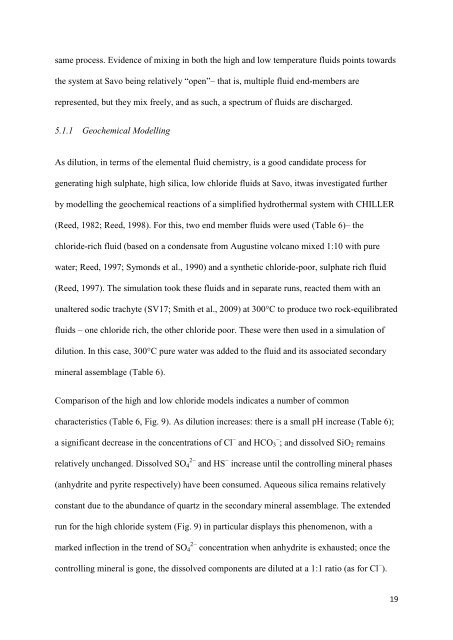Alkaline sulphate fluids produced in a magmatic hydrothermal system
Alkaline sulphate fluids produced in a magmatic hydrothermal system
Alkaline sulphate fluids produced in a magmatic hydrothermal system
You also want an ePaper? Increase the reach of your titles
YUMPU automatically turns print PDFs into web optimized ePapers that Google loves.
same process. Evidence of mix<strong>in</strong>g <strong>in</strong> both the high and low temperature <strong>fluids</strong> po<strong>in</strong>ts towards<br />
the <strong>system</strong> at Savo be<strong>in</strong>g relatively “open”– that is, multiple fluid end-members are<br />
represented, but they mix freely, and as such, a spectrum of <strong>fluids</strong> are discharged.<br />
5.1.1 Geochemical Modell<strong>in</strong>g<br />
As dilution, <strong>in</strong> terms of the elemental fluid chemistry, is a good candidate process for<br />
generat<strong>in</strong>g high <strong>sulphate</strong>, high silica, low chloride <strong>fluids</strong> at Savo, itwas <strong>in</strong>vestigated further<br />
by modell<strong>in</strong>g the geochemical reactions of a simplified <strong>hydrothermal</strong> <strong>system</strong> with CHILLER<br />
(Reed, 1982; Reed, 1998). For this, two end member <strong>fluids</strong> were used (Table 6)– the<br />
chloride-rich fluid (based on a condensate from August<strong>in</strong>e volcano mixed 1:10 with pure<br />
water; Reed, 1997; Symonds et al., 1990) and a synthetic chloride-poor, <strong>sulphate</strong> rich fluid<br />
(Reed, 1997). The simulation took these <strong>fluids</strong> and <strong>in</strong> separate runs, reacted them with an<br />
unaltered sodic trachyte (SV17; Smith et al., 2009) at 300°C to produce two rock-equilibrated<br />
<strong>fluids</strong> – one chloride rich, the other chloride poor. These were then used <strong>in</strong> a simulation of<br />
dilution. In this case, 300°C pure water was added to the fluid and its associated secondary<br />
m<strong>in</strong>eral assemblage (Table 6).<br />
Comparison of the high and low chloride models <strong>in</strong>dicates a number of common<br />
characteristics (Table 6, Fig. 9). As dilution <strong>in</strong>creases: there is a small pH <strong>in</strong>crease (Table 6);<br />
a significant decrease <strong>in</strong> the concentrations of Cl − and HCO − 3 ; and dissolved SiO 2 rema<strong>in</strong>s<br />
relatively unchanged. Dissolved SO 2− 4 and HS − <strong>in</strong>crease until the controll<strong>in</strong>g m<strong>in</strong>eral phases<br />
(anhydrite and pyrite respectively) have been consumed. Aqueous silica rema<strong>in</strong>s relatively<br />
constant due to the abundance of quartz <strong>in</strong> the secondary m<strong>in</strong>eral assemblage. The extended<br />
run for the high chloride <strong>system</strong> (Fig. 9) <strong>in</strong> particular displays this phenomenon, with a<br />
marked <strong>in</strong>flection <strong>in</strong> the trend of SO 2− 4 concentration when anhydrite is exhausted; once the<br />
controll<strong>in</strong>g m<strong>in</strong>eral is gone, the dissolved components are diluted at a 1:1 ratio (as for Cl − ).<br />
19
















